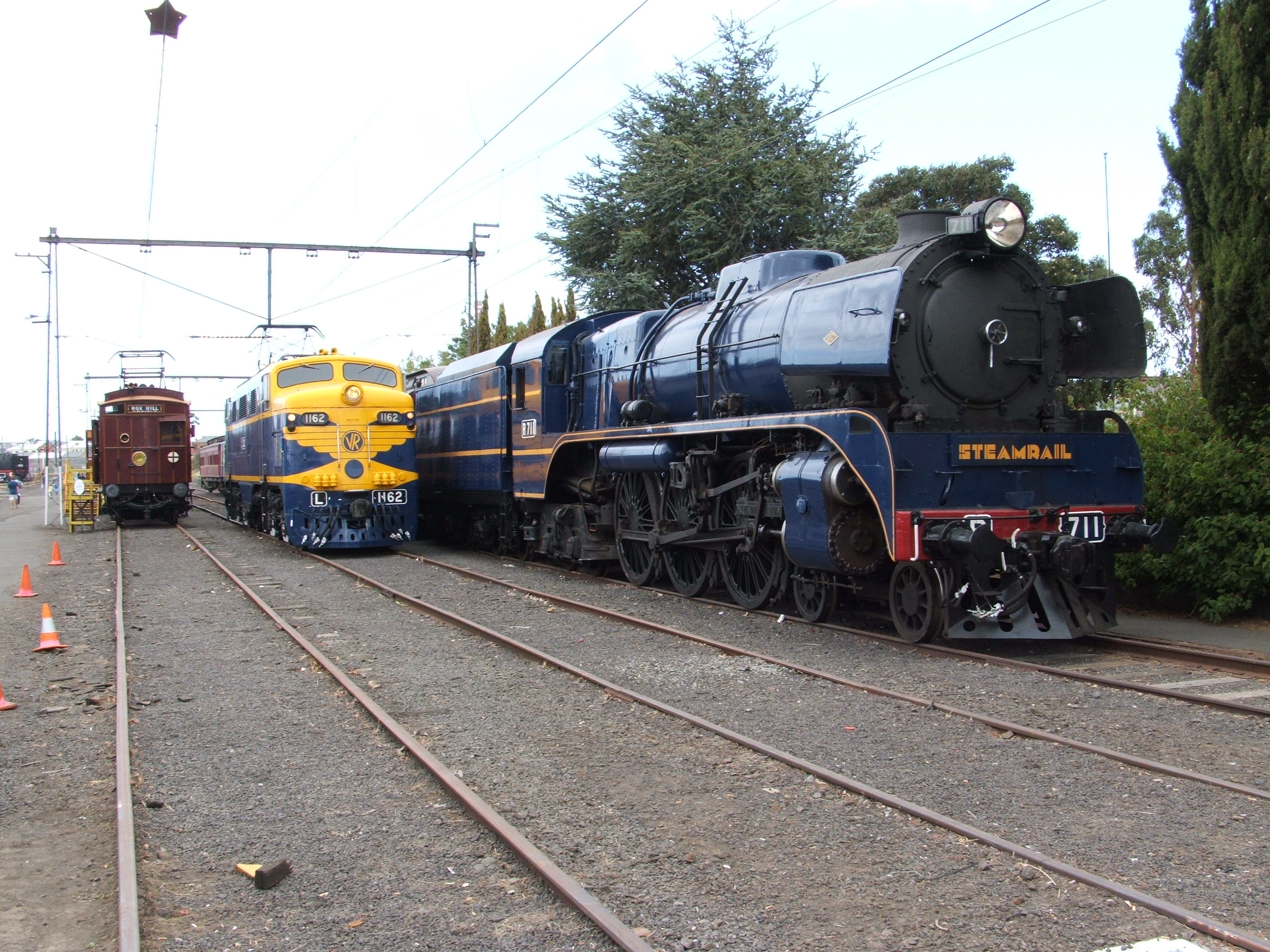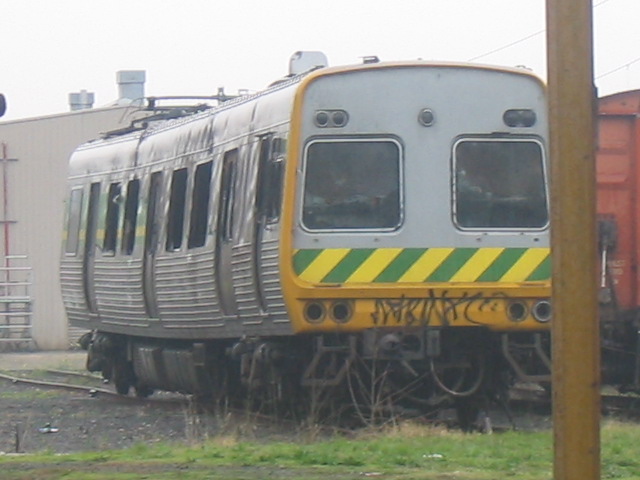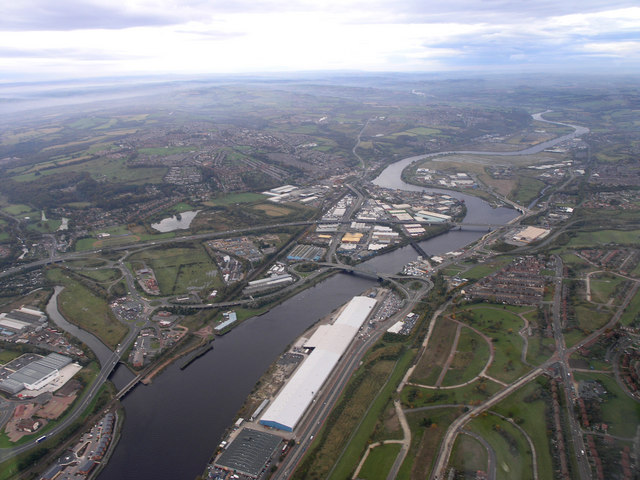|
N Type Carriage
The N type carriages are an intercity Passenger car (rail), passenger carriage used on the Rail transport in Victoria, railways of Victoria, Australia. They were introduced between 1981 and 1984 as part of the 'New Deal (railway), New Deal' reforms of country passenger rail services. Today they are seen on V/Line long distance InterCity services to Swan Hill. The carriage sets have both first class 2+2 seating, and 2+3 economy seating. Snack bar facilities are also provided on board. Originally delivered as three-car sets, some sets were extended in length with S type carriage, S and Z type carriages. Today the carriages are hauled by V/Line N class (diesel), N class diesel locomotives. The carriages can use an external head end power supply for lighting and air conditioning operation. Each carriage has two swing doors per side, which were originally manually opened by passengers, but have since been converted to powered operation, and they are locked or unlocked by the conduc ... [...More Info...] [...Related Items...] OR: [Wikipedia] [Google] [Baidu] |
Newport Workshops
The Newport Railway Workshops is a facility in the Melbourne suburb of Newport, Victoria, Newport, Australia, that builds, maintains and refurbishes Rolling stock, railway rollingstock. It is located between the Williamstown railway line, Williamstown and Werribee railway lines. History Plans for a workshop at Newport started in the 1860s, to replace the temporary Williamstown Workshops but nothing came of it. It was not until 1880 that work began, when the Victorian Railways purchased annexes used at the Melbourne International Exhibition (1880), 1880 Melbourne Exhibition and erected one of them at Newport, naming it the Newport Carriage Workshops when it began operation in 1882. Construction of the permanent workshops commenced in 1884, and was completed in 1889. Although the earlier carriage workshop closed at this time, it reopened in 1895 to manufacture signal equipment. The first Railroad car, carriages built by the workshops were completed in 1889, but early locomotives w ... [...More Info...] [...Related Items...] OR: [Wikipedia] [Google] [Baidu] |
Ballarat V/Line Rail Service
The Ballarat line is a regional passenger rail service operated by V/Line in Victoria, Australia. It serves 13 stations towards its terminus in Ballarat's western suburb of Wendouree via Melton and Bacchus Marsh. Services are operated primarily using V/Line VLocity diesel multiple unit sets in either 3- or 6-car configurations. It is the second most-used regional rail service in Victoria (behind the Geelong line), carrying 4.68 million passengers in the 2022-23 financial year. The Ararat line extends further west from Wendouree to Ararat, while the Maryborough line is operated primarily as a shuttle from Ballarat along the Mildura line to Maryborough. History 20th century V/Line operated services along the original Serviceton railway line as far as Horsham and Dimboola. Several stations, including Gordon and Warrenheip, were closed in 1981 as part of the New Deal reforms to Victoria's country rail services. Services to Mildura, which ran via Ballarat, ... [...More Info...] [...Related Items...] OR: [Wikipedia] [Google] [Baidu] |
DRC Railcar
The DRC (Diesel Rail Car) is a class of railmotor operated by the Victorian Railways on its country rail network in Victoria, Australia. The cars were built by Tulloch Limited in New South Wales, and featured aluminium and steel construction, air-conditioning, and twin diesel engines with hydraulic transmissions. History The first railcars of this type were built in 1970 for the New South Wales Government Railways as 1200 class railcars. The Victorian Railways decided to order two railcars of the same design, to replace the 280hp Walker railmotors then in use. The first DRC entered service in May 1971, classified DRC40, followed by DRC41 in November 1971. The NSW fleet suffered numerous failures in service, and by 1974 the NSW Public Transport Commission had decided to withdraw the cars from service. Eight of them were converted to loco-hauled carriages in 1982, and used on the '' South Coast Daylight Express'' until January 1991, and on Moss Vale and Goulburn services un ... [...More Info...] [...Related Items...] OR: [Wikipedia] [Google] [Baidu] |
Comeng (train)
The Comeng ( ) is a class of electric multiple unit (EMU) operating on the Railways in Melbourne, suburban railway network of Melbourne. Built by their namesake Commonwealth Engineering (abbreviated as Comeng), the trains were introduced in 1981 as a replacement for the Tait (train), Tait and Harris (train), Harris trains. In total, 190 three-car trainsets were built, although only 110 remain in service and are expected to be retired by 2030. The fleet underwent two major refurbishments. The first, a mid-life refurbishment, was carried out from 2000 to 2003 by Alstom and Downer Rail, EDi Rail. The second, named the Comeng Life Extension Project, completed between 2017 and 2021, aimed to extend the trains' lifespan to meet their gradual replacement by the High Capacity Metro Train, High Capacity Metro Trains and the X'Trapolis 2.0 trains. Alongside these upgrades, a number of minor improvement programs were also conducted on the trains to further enhance their efficiency, safety, ... [...More Info...] [...Related Items...] OR: [Wikipedia] [Google] [Baidu] |
Ansett Australia
Ansett Australia, originally Ansett Airways, was a major Australian airline group based in Melbourne, Victoria. The company operated domestically within Australia, and from the 1990s, to destinations in Asia. Following 65 years of operation, the airline went into administration in 2001 following a financial collapse and subsequent liquidation in 2002, subject to a deed of company arrangement. Ansett’s last flight touched down on 5 March 2002. History Beginning The company was founded by Reginald " Reg" Ansett in 1935 as Ansett Airways Pty Ltd. This was an offshoot of his road transport business, which had become so successful it was threatening the freight and passenger revenue of Victorian Railways. This led the state government to legislate to put private road transport operators out of business. Reg Ansett countered by establishing an airline, as aviation was under control of the federal government and beyond the reach of the state government. Ansett's first route betwee ... [...More Info...] [...Related Items...] OR: [Wikipedia] [Google] [Baidu] |
Vickers Ruwolt
Vickers-Armstrongs Limited was a British engineering conglomerate formed by the merger of the assets of Vickers Limited and Sir W G Armstrong Whitworth & Company in 1927. The majority of the company was nationalised in the 1960s and 1970s, with the remainder being divested as Vickers plc in 1977. It featured among Britain's most prominent armaments firms. History Vickers merged with the Tyneside-based engineering company Armstrong Whitworth, founded by William Armstrong, to become Vickers-Armstrongs. Armstrong Whitworth and Vickers had developed along similar lines, expanding into various military sectors and produced a whole suite of military products. Armstrong Whitworth were notable for their artillery manufacture at Elswick and shipbuilding at a yard at High Walker on the River Tyne. 1929 saw the merger of the acquired railway business with those of Cammell Laird to form Metropolitan Cammell Carriage and Wagon (MCCW); Metro Cammell. In 1935, before rearmament began, ... [...More Info...] [...Related Items...] OR: [Wikipedia] [Google] [Baidu] |
Pirelli
Pirelli & C. S.p.A. is an Italian multinational tyre manufacturer based in the city of Milan, Italy. The company, which has been listed on the Borsa Italiana since 1922, is the 5th-largest tyre manufacturer, and is focused on the consumer production of tyres for cars, motorcycles and bicycles. It is present in Europe, the Asia-Pacific, Latin America, North America, and the post-Soviet states, operating commercially in over 160 countries. It has 19 manufacturing sites, across 13 countries, and a network of around 14,600 distributors and retailers. In 2015, China National Chemical Corp. Ltd. ( ChemChina) took controlling interest of Pirelli; with the Chinese state-owned company agreeing to maintain the tyre company's ownership structure until 2023. Pirelli has been sponsoring sport competitions since 1907 and is the exclusive tyre partner and supplier for the Grand-Am Rolex Sports Car Series for 2008–2010, FIA Formula One World Championship for 2011–present and for the FI ... [...More Info...] [...Related Items...] OR: [Wikipedia] [Google] [Baidu] |
Swan Hill Railway Station
Swan Hill railway station is located on the Piangil line in Victoria, Australia. It serves the city of Swan Hill, and it opened on 30 May 1890.Swan Hill Vicsig The station serves as the current terminus for V/Line's Swan Hill line services. Beyond the station, Pacific National and Southern Sho ... [...More Info...] [...Related Items...] OR: [Wikipedia] [Google] [Baidu] |
Bendigo Railway Line
The Deniliquin railway line (also known as the Bendigo railway line or the Echuca railway line) is a broad-gauge railway line serving north-western Victoria, Australia. The line runs from the New South Wales town of Deniliquin into Bendigo, before turning south-south-east towards Melbourne, terminating in Docklands near the central business district. It is a major trunk line both for passenger and freight trains, with many lines branching off from it. History The Company Construction of the line was begun by the Melbourne, Mount Alexander & Murray River Railway Company, which was incorporated in 1852. The first thirteen sections of the line were constructed by contractors Cornish & Bruce, who gained a reputation for trying to reduce costs by taking shortcuts on materials and reducing worker's wages. The company made almost no progress on the construction of the railway due to an inability to raise sufficient funds, and in 1856 it was purchased by the Victorian Government. ... [...More Info...] [...Related Items...] OR: [Wikipedia] [Google] [Baidu] |
Standard Gauge
A standard-gauge railway is a railway with a track gauge of . The standard gauge is also called Stephenson gauge (after George Stephenson), international gauge, UIC gauge, uniform gauge, normal gauge in Europe, and SGR in East Africa. It is the most widely used track gauge around the world, with about 55% of the lines in the world using it. All high-speed rail lines use standard gauge except High-speed rail in Russia, those in Russia, High-speed rail in Finland, Finland, High-speed rail in Uzbekistan, Uzbekistan, and some line sections in High-speed rail in Spain, Spain. The distance between the inside edges of the heads of the rails is defined to be 1,435 mm except in the United States, Canada, and on some heritage British lines, where it is defined in Imperial and US customary measurement systems, U.S. customary/Imperial units, British Imperial units as exactly "four feet eight and one half inches", which is equivalent to 1,435.1mm. History As railways developed and expa ... [...More Info...] [...Related Items...] OR: [Wikipedia] [Google] [Baidu] |
Track Gauge Conversion
Track gauge conversion is the changing of one railway track gauge (the distance between the running rails) to another. In general, requirements depend on whether the conversion is from a wider gauge to a narrower gauge or vice versa, on how the rail vehicles can be modified to accommodate a track gauge conversion, and on whether the gauge conversion is manual or automated. Sleepers If tracks are converted to a narrower gauge, the existing timber sleepers (ties) may be used. However, replacement is required if the conversion is to a significantly wider gauge. Some sleepers may be long enough to accommodate the fittings of both existing and alternative gauges. Wooden sleepers are suitable for conversion because they can be drilled for the repositioned rail spikes. Concrete sleepers are unsuitable for conversion. Concrete sleepers may be cast with alternative gauge fittings in place, an example being those used during the conversion of the Melbourne–Adelaide railway from to . ... [...More Info...] [...Related Items...] OR: [Wikipedia] [Google] [Baidu] |
Albury V/Line Rail Service
The Albury line is a regional passenger rail service operated by V/Line in Victoria, Australia. It serves passengers between the state capital of Melbourne and the regional cities of Benalla, Wangaratta, Wodonga, and the NSW border city of Albury. History 21st century Conversion to standard gauge After February 2008, train services on the line terminated at Wangaratta station, with road coaches operating from Wangaratta to Albury. This was due to the deteriorating track conditions between Seymour and Albury which were resulting in train speeds being reduced from , and trains not being able to make the return journey in the timetabled period. On 30 May 2008, the then Premier of Victoria John Brumby announced the broad gauge track between Seymour and Albury would be converted to standard gauge, with the project to be combined with the Wodonga Rail Bypass away from the Wodonga CBD. Three V/Line passenger locomotives and 15 passenger carriages were also to be converted to sta ... [...More Info...] [...Related Items...] OR: [Wikipedia] [Google] [Baidu] |




